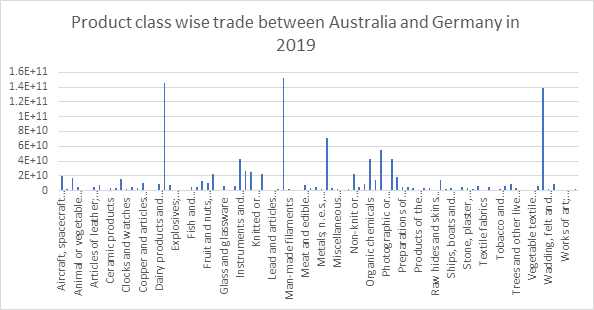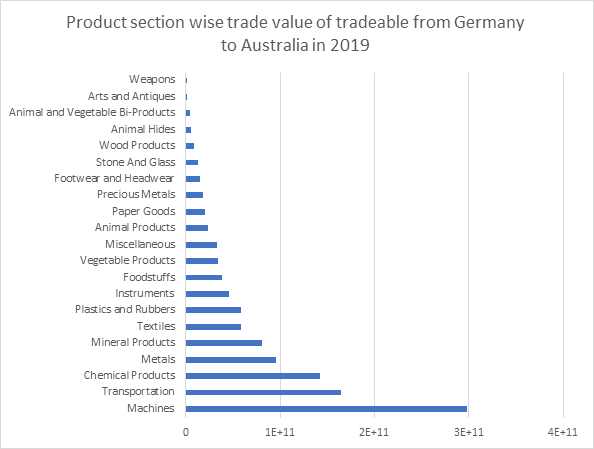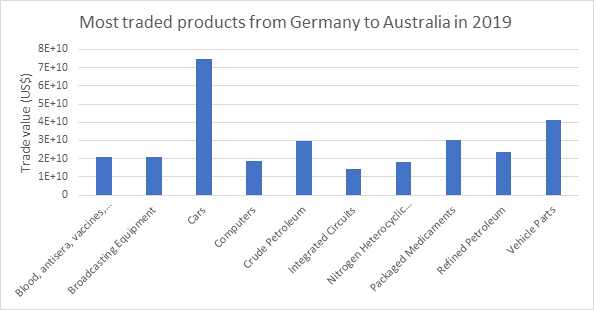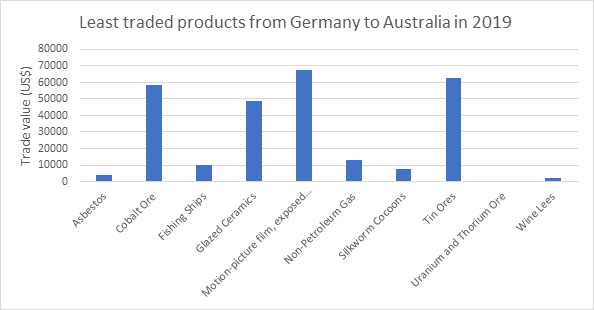Data Visualisation Software assignment
Question
Task: Data Visualisation Software assignment?
Answer
Introduction:
Since 2013, Germany and Australia have been strategic partner and 2021 onwards, cooperation between two intensified with increased business. Major growth in cooperation between two nations can be seen in case of tourism, academic world, machinery, chemical product, mineral products. The cooperation between two nations is based on the shared values and support for the further development and preservation of the rule based international order. In European market, Germany is the second biggest trading partner of Australia after UK (auswaertiges-amt.de 2022). Products that are mainly exported from Germany are heavy machineries, automobile and their parts, pharmaceuticals. Whereas, Australia export mineral-based products, agricultural products, gold and chemical-based products. Germany is the second largest trading partner of Australia after China. Australia is one of the largest trading powers in the Indo-Pacific region that has strong global interests. Underpinning the increasing importance of Australian market in international trade and trade relation with Germany from Australia, it is now under debate that whether Free Trade Agreement (FTA) can be developed between two or not. This study has provided light on the situation backed by strong empirical evidences of bilateral trade between Germany and Australia.
Analysis outcome:
To analyse the trade between Germany and Australia, visualisation has been created here using excel.

Figure 1: Product class wise trade value
As per the figure 1, it can be seen that the tradeable item between Germany and Australia is high and it has 96 different classes. The value of tradeable items between Germany and Australia ranges between $74982629814 US$ and $150 US (figure 1). Electrical machinery, automobile and parts are the main importable from Germany during 2019.

Figure 2: Product section wise trade value
As per the figure 2, it can be seen that machine are the most valued product section among all class followed by chimerical products, minerals. Weaponry is the most minor valued product among all the classes, preceded by animal and vegetable by-products, wood products. The second product class, compared to the top product class, values almost half.

Figure 3: Most traded product from Germany to Australia in 2019
As per the figure 2, vehicles and their parts were traded with the highest value in 2019 from Australia to Germany. Chemical products and mineral products hold second and third valuable imports from Germany to Australia during 2019. Within machines, electrical machinery and equipment were accounted for most of the values in trade in 2019.

Figure 4: least traded product from Germany to Australia in 2019
As per the figure 4, it can be seen that among least trade items, motion picture, exposed and developed films have the highest value, followed by tin ores, cobalt ores and glazed ceramics.
FTA is a complex business tie-up between trading partners and it has various benefit and complexities. Free trade will certainly enhance the growth of bilateral business and reduce the government spending in export promotion; whereas, it will result in faster degradation of natural resources (Culas and Timsina 2019). Moreover, job outsourcing will increase and working condition may worsen. Underpinning the empirical evidences found above, it is clear that if FTA occurs, then it will reduce the tax burden on the Australian traders, however, it will lead to higher import too and loss in government revenue. At present government earns 5% of the value of imported goods as tax and 10% of GST on total value from items that are imported from Germany (Austrade.gov.au 2022). If FTA is developed between Germany and Australia, then it will result in fall in government revenue which is supposed to be earned by the government. Due to fall in tax, imported item from Germany will become cheaper in the Australia market causing higher import and negative effect on exchange rate of Australia.
However, FTA will boost the export from Australia to Germany as well. Germany imposes 19% VAT on product imported from Australia; with imposition of FTA, this VAT will be exempted allowing Australian product to be cheaper in German market that will enhance the demand for exportable (Austrade.gov.au 2022). This increased demand will cause rise in the exchange rate for Australia. From the comparative analysis of the export value, it can be seen that during 2020, total export from Germany to Australia was $9.67 billion whereas, from Australia to Germany, it was $1.99B (oec.word 2022). With FTA, value of trade is supposed to rise, however, FTA with Germany will put negative impact on the Australian economy. FTA will certainly increase the trade of cars at reduced cost from Germany in Australian market, however, with rise in import and downward pressure on exchange rate, Australian economy will face negative impact (Yao et al. 2019).
Justification of visualisation:
Visualisation made here are produced underpinning the Tufte’s principle. Here visualisations use labels and detailed and quantified with proper units as applicable for each image (lesson 8, slide 7-8). For instance, all four figures have their unique title that depicts the reason of the visualisation. Each axis of the figure demonstrates two variables only that makes it clear to depict and easy to understand. For instance, figure 2, represent trade value in X axis, and product class in Y axis. For visualisation 1, X axis represent the trade value and product class is represented in Y axis. For figure 3 and 4, trade value is represented in Y axis and X axis represent product. Intention of the visualisation is clear and no hidden meaning is there and it does not mould the data and its story (lesson 8, slide 7-8). With the clear title for each image, intention of making the visualisation is clear and there is no hidden meaning. Moreover, data was retrieved from the authentic source only and for visualisation no alternation in data has been done. Hence, the visualisation follows all six principles of Tufte (lesson 8, slide 7-8).
Coming to the cognitive load factors it can be stated that all visualisation was made to keep cognitive low minimal. For instance, in the first figure, cognitive load is moderate here and can be scored as 6 as the visualisation needs a moderate mental load to be understood (lesson 8, slide 5). For the second figure, cognitive value is low here as visualisation clearly tells which product class is the most valued and least valued tradeable in 2019 between Australia and Germany. For the third and fourth figure, cognitive load is also low here as the figures clearly tells which are the least and most traded product in 2019 between Australia and Germany. Based on the pre attentive attribute, it can be stated that all figures as used line graphs, so that reader can perceive the information from figure quickly considering orientation, length and width of the lines (lesson 8, slide 7-10).
Conclusion:
As per the above analysis, it can be stated that, FTA is supposed to enhance the bilateral trade, however, it will have negative impact on the Australian economy. Due to the comparatively smaller trade value of export from Australia to Germany, FTA will bring in negative effect on the Australian economy. However, FTA can enhance the bilateral trade of cars, machinery, pharmaceuticals from Germany to Australia and mineral and agriculture-based product from Australia to Germany. To conclude, underpinning the empirical analysis, it can be mentioned that FTA between Germany in Australian will not be good from Australian perspective.
Reference:
Austrade.gov.au 2022. Doing business - Taxation – Germany – For Australian. https://www.austrade.gov.au/australian/export/export-markets/countries/germany/doing-business/taxation
Austrade.gov.au 2022. Market profile – Germany – For Australian exporters, Australian Trade and Investment Commission. https://www.austrade.gov.au/australian/export/export-markets/countries/germany/market-profile/market-profile
auswaertiges-amt.de 2022. Germany and Australia: Bilateral relations, German Federal Foreign Office. https://www.auswaertiges-amt.de/en/aussenpolitik/laenderinformationen/australien-node/australia/229486#:~:text=Germany's%20main%20exports%20to%20Australia,metals%2C%20coins%20and%20agricultural%20products
Culas, R.J. and Timsina, K.P., 2019. Impacts of China-Australia free trade agreement on Australian agriproducts trade. Australasian Agribusiness Review, 24(1673-2020-275), pp.128-148. https://ageconsearch.umn.edu/record/301063/files/AAR-Vol-27-Paper-6-Culas-and-Timsina.pdf
Oec.world 2022. Germany (DEU) and Australia (AUS) Trade | OEC (2022). https://oec.world/en/profile/bilateral-country/deu/partner/aus
Yao, X., Yasmeen, R., Li, Y., Hafeez, M. and Padda, I.U.H., 2019. Free trade agreements and environment for sustainable development: a gravity model analysis. Sustainability, 11(3), p.597. https://www.mdpi.com/2071-1050/11/3/597/pdf












